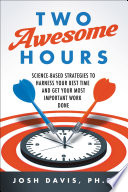

The book introduces the concept of 'Awesome Hours,' which are defined as focused, high-quality work periods that allow individuals to achieve maximum productivity. The author emphasizes that these hours are not about the quantity of work done but rather the quality and intensity of focus. By identifying when you are most productive during the day, you can allocate these 'Awesome Hours' to your most important tasks. The book outlines strategies for recognizing your peak performance times and how to structure your day around them. This approach encourages readers to prioritize their energy and focus on tasks that yield the highest return on investment, rather than simply working longer hours.
Continue readingEnergy management is a core principle in 'Two Awesome Hours.' The author argues that managing your energy levels is just as important as managing your time. This involves understanding your natural rhythms and knowing when you are most alert and creative. The book provides practical tips for maintaining high energy levels throughout the day, such as taking breaks, staying hydrated, and engaging in physical activity. By aligning your work with your energy peaks, you can enhance your productivity and creativity, ultimately leading to better outcomes in your professional and personal life.
Continue readingDistractions are one of the biggest barriers to achieving 'Awesome Hours.' The book discusses various types of distractions—both internal (like self-doubt) and external (like notifications and social media)—and provides strategies for minimizing them. Techniques such as setting boundaries, creating a conducive work environment, and using technology to your advantage are highlighted. The author stresses the importance of creating a 'distraction-free zone' during your Awesome Hours, allowing for deep work and concentration, which are essential for high-quality output.
Continue readingIntentional planning is a key strategy discussed in the book. The author encourages readers to plan their days and weeks with purpose, ensuring that their Awesome Hours are allocated to the most critical tasks. This involves setting clear goals, prioritizing tasks based on their importance and urgency, and being flexible enough to adjust plans as needed. The book also emphasizes the importance of reflection and review, allowing individuals to assess their productivity and make necessary adjustments to their planning process. By being intentional about planning, readers can maximize the effectiveness of their Awesome Hours.
Continue readingMindfulness plays a significant role in achieving productive Awesome Hours. The book highlights the connection between mindfulness practices and enhanced focus and creativity. Techniques such as meditation, deep breathing, and being present in the moment are discussed as ways to cultivate a mindset conducive to deep work. The author explains that by practicing mindfulness, individuals can reduce stress, improve concentration, and enhance their overall work experience. This idea encourages readers to incorporate mindfulness into their daily routines to support their productivity goals.
Continue readingAccountability is another vital aspect of achieving productivity as described in 'Two Awesome Hours.' The author discusses how having an accountability partner or group can significantly enhance motivation and commitment to goals. By sharing your objectives with others, you create a sense of responsibility that can drive you to take action. The book suggests strategies for finding accountability partners and establishing regular check-ins to discuss progress and challenges. This communal approach to productivity fosters a supportive environment that can help individuals stay on track and achieve their Awesome Hours.
Continue readingThe book concludes with the idea of cultivating a growth mindset as essential for long-term productivity and success. The author emphasizes that viewing challenges as opportunities for growth rather than obstacles is crucial for maintaining motivation and resilience. By adopting a growth mindset, individuals can learn from setbacks, embrace continuous improvement, and remain open to new ideas and approaches. This mindset not only enhances personal productivity but also contributes to a more innovative and adaptive work culture.
Continue reading